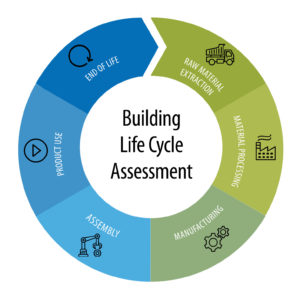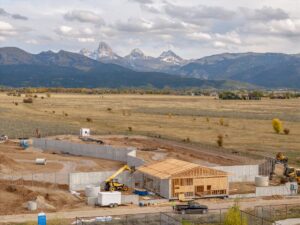Life-Cycle Assessment (LCA), or cradle-to-grave analysis, is an assessment tool used to calculate the environmental impacts and resources used across a product’s entire life cycle: raw material extraction (cradle), manufacturing, packaging, distribution, use, and end of life (grave). The increasing focus on environmental, social, and economic sustainability has amplified the application of life cycle thinking over a product’s life cycle, and LCA’s are increasingly used as a tool to support these sustainability goals.
Defined by the International Standards of Organization (ISO) as “the compilation and evaluation of the inputs and outputs and the potential impacts of a product system throughout its life cycle,” LCAs follow a four-stage process outlined in the international standard (ISO 14000 Series): Goal and Scope Definition, Life Cycle Inventory (LCI), Life Cycle Impact Assessment (LCIA), and Interpretation of Results. The LCA approach covers the whole life of a product from the cradle to the grave. All the input process steps (materials and energy) and outputs (environmental impacts) are identified for each stage in the product’s life cycle. Typical environmental impacts or indicators include Acidification, Eutrophication, Global Warming Potential (GWP), Ozone Depletion Potential (ODP), Smog Formation Potential (Tropospheric Ozone), Non-Renewable Resources Use, among others.
Whole Building LCA (WBLCA)
Buildings are responsible for more than 40 percent of energy usage in the United States. Generally, building energy use can be classified into two categories: operational energy and embodied energy. The embodied energy comes from the building materials extraction, manufacturing, transportation, construction, repair/maintenance, and end of life phases of the building project. As there has been a trend for building projects to move towards net-zero buildings, most of the impacts will come from embodied energy, as systems can be designed to cover operational energy needs with on/off-site renewable energy generation. Therefore, understanding embodied energy has become more critical as measures to reduce the overall energy use of the building. WBLCA can act as an important and primary tool for assessing the embodied energy in buildings.
A WBLCA also serves as one of the most effective ways to determine the impact on the environment resulting from material use, construction methods, energy concepts, components, and products. This involves all aspects of planning that occur in the construction of a new building and a renovation project. The primary data source required for a WBLCA is an Environmental Product Declaration (EPD). According to the Green Building Certification, Inc. (GBCI), “EPD is an internationally accepted, verified, and published a report focusing on how a product affects the environment throughout its life cycle.” EPDs provide informational resources that help architects, designers, builders, and purchasers to better understand the product’s environmental qualities and impacts.

A WBLCA allows designers/owners to evaluate the effect on the environment of product, service, or process, and accordingly helps designers to choose a more sustainable alternative available in the industry. Because a WBLCA considers what happens before and after the product is used in the project, it helps the designers/owners measure environmental effects over a long period of time. It can be used to identify the building’s environmental impacts in the early design phase. WBLCA results can help answer numerous questions about the carbon footprint and environmental impacts that arise during the design and construction of a green building, as well as bolster design decisions by providing scientific evidence and justification. It helps to visualize carbon emissions saving by increasing recycled content in steel, adding fly ash content in concrete, using local building materials, and others.
WBLCA results can answer questions that can help in material selection and design decisions. For example, it can help to understand which material is less environmentally impactful if installed on the project, such as Poly Vinyl Chloride (PVC) or Styrene-Butadiene-Styrene (SBS) for the roofing membrane; and Polyisocyanurate (PIR) foam panels or Extruded Polystyrene (XPS) foam panels or Expanded Polystyrene (EPS) foam panels for the insulation. Based on a WBLCA result, the project can select the most environment-friendly design among available design options. Since investors, tenants, building owners, cities, and other stakeholders often look for buildings with a lower carbon footprint and environmental impacts, WBLCA results can act as an indicator to help in making environment-conscious decisions. Furthermore, a WBLCA can provide significant credit in various green building rating systems.
A WBLCA for Green Building Rating Systems
The use of a WBLCA provides different scores according to types of green building rating systems:
- Under the Building life-cycle impact reduction (option 4 for both v4 and v4.1 rating system) of the Leadership in Energy and Environmental Design (LEED) Rating System, the analysis of a baseline versus proposed WBLCA is worth 4 points. Additionally, the LEED v4.1 Pilot Credit – Procurement of Low Carbon Construction Materials provides an opportunity of an additional 1 point for reducing the embodied carbon materials used in the construction.
- In the Green Globes for New Construction rating system, the comparative core and shell WBLCA is worth 33 points for the performance path or 20 points for the prescriptive path.
- In the Living Building Challenge rating system, projects must offset total embodied carbon by 100% from construction through a one-time carbon offset. The project may conduct a WBLCA, report total embodied carbon, and purchase an offset for embodied carbon in order to achieve a 100% one-time carbon offset.
- In the Parksmart rating system, the project can achieve 2-6 points (depending on the total project cost) for using a WBLCA to compare a baseline model to the proposed building.
- In the BREEAM rating system, the project can achieve 1-6 credits for using a WBLCA to measure the life cycle environmental impact of the building elements.
- Under the DGNB rating system, a comparative WBLCA calculation can achieve a maximum of 100 points. More points may be awarded for demonstrating an LCA in various stages and processes.
We have conducted numerous LCAs and WBLCAs at the regional and national levels to help design teams reduce the embodied carbon, environmental impacts, and carbon footprint of the built environment, as well as document savings and earn points in the associated green building rating systems.
Reach out to our experts to discover how we can help you perform an LCA or WBLCA: in@epstengroup.com.




